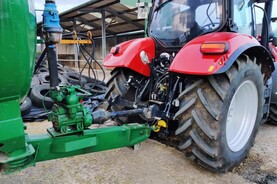Minister of State Martin Heydon has urged farmers to keep safety to the fore when handling slurry.
"With the improving weather and soil conditions, farmers are catching up with work. The next few weeks will be a very busy period for farmers and contractors. I urge all farmers not to sacrifice safety in the rush to complete tasks such as slurry spreading.”
While the number of fatal incidents due to slurry has reduced in recent years, Health and Safety Authority data shows that over the past decade, on average, one person has lost their life each year as a result of drowning, asphyxiation due to gas or due to poorly maintained slurry equipment.
In the 10 year period 2014-2023, there were seven drowning fatalities on farms involving open slurry pits and slurry tanks.
Even with good facilities, there is a risk of falling into a temporarily opened slurry tank during agitation or extraction of slurry.
Reminding farmers of the risks around slurry storage, Minister Heydon said: “With slurry, there is an almost ever-present risk of drowning.
"Open slurry pits without childproof and stockproof fencing and open agitation points are a serious risk to life. Farmers should consider the TAMS 3 Farm Safety Capital Investment Scheme for support with investments to make their slurry storage facilities safer.”
Precautions
Before agitating or spreading slurry, farmers should ensure that tractors, agitators and slurry tankers are in good condition. Brakes, lights, power-take-off (PTO) shaft covers and guards, hydraulic coupling and hoses and hitches should be checked to ensure they are in good working order.
Children should be kept away from the farmyard, slurry tanks and pits and machinery when agitation and spreading are taking place.
Agitation
Slurry gases are a serious risk to safety during slurry agitation and for a period of at least 30 minutes afterwards. This risk can be managed by a few simple steps.
Check the weather forecast to ensure good conditions, particularly that there is adequate air movement to disperse slurry gases. By agitating on a windy day, gases released during the agitation are dispersed.
Remove all livestock from the slatted shed and open all doors before commencing tank agitation.
At least two people should be present and they should stay up-wind.
There should be no-one in the shed while the tank is being agitated – or in any building that shares a common airspace with it – for at least 30 minutes after agitating has finished. Ensure gases do not drift and build up in poorly ventilated areas of adjacent buildings.
Even with outdoor agitation points, slurry gas can build up to harmful levels where they are in sheltered areas such as between buildings or close to a hedge because of reduced air movement.
Agitating a tank from an internal agitation point is not appropriate due to the risk posed by slurry gas.
Never extend a building by roofing over an existing outdoor agitation point unless the agitation point is moved.
Further information is available here .






 This is a subscriber-only article
This is a subscriber-only article










SHARING OPTIONS: